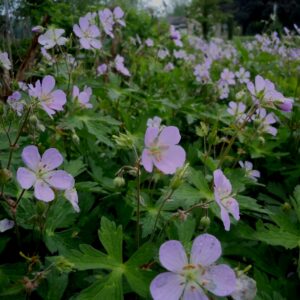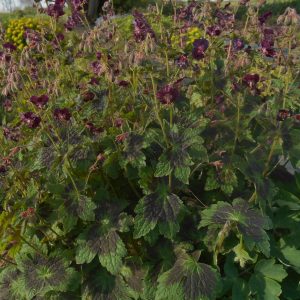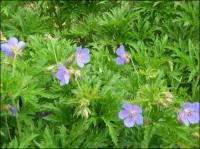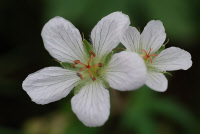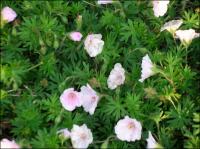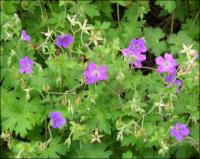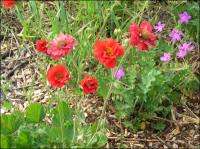Perennials & Biennials
Showing 193–200 of 485 results
-
Geranium maculatum American Cranesbill, Wild geranium, Spotted geranium Z 3-8
Clusters of two to five pink infused with lavender, flowers of five, paddle-shaped petals bloom in late spring to early summer.
Clusters of two to five pink infused with lavender, flowers of five, paddle-shaped petals bloom in late spring to early summer.
Size: 24" x 18"
Care: Full sun to part shade in moist to moist well-drained soil
Native: East North America, Wisconsin native.
Wildlife Value: primarily visited by several kinds of bees.Native Americans taught colonists to use the plant to cure diarrhea, dysentery, and hemorrhaging. Also used on sores, open wounds, canker sores and sore feet. The Choctaw prescribed it for venereal disease. Sent to Europe in 1732. Jefferson asked John Bartram to obtain seeds, 1786. Collected by French plant hunter André Michaux (1746-1802). Pressed specimen in Emily Dickinson’s herbarium.
-
Geranium phaeum ‘Samobor’ Mourning widow Z 4-9
Very distinctive, variegated, chocolate-green chevron-marked leaves. Nodding, eggplant purple flowers in late spring-early summer.
Very distinctive, variegated, chocolate-green chevron-marked leaves. Nodding, eggplant purple flowers in late spring-early summer.
Size: 12-15” x 12"
Care: part sun to shade in moist well-drained soil
Native: Croatia
Wildlife Value: Deer & rabbit resistant. Attracts butterflies and other pollinatorsOK you caught me, it’s not heirloom – this had its 34th birthday in 2024. In three decades, it will be eligible for Social Security. It’s such a wonderful plant it’s Ok to make an occasional exception. It is a natural, genetic variant found growing in damp woods in Croatia. Named for the Croatian town of Samobor where the very first ‘Samobor’ still grows. Discovered in 1990 by Elizabeth Strangman of Washfield Nursery in Kent England.
-
Geranium pratense Meadow Cranesbill Z 4-7
Clusters of saucer-shaped blue-violet flowers of five, paddle-shaped petals bloom in late spring to early summer.
Clusters of saucer-shaped blue-violet flowers of five, paddle-shaped petals bloom in late spring to early summer.
Size: 24-36" x 24"
Care: Full sun in moist to well-drained soil
Native: Northern Europe, central Asia
Wildlife Value: High sugar content in nectar feeds many pollinators. Deer and rabbit resistant.Geranium is Greek meaning “crane” referring to the shape of its seed resembling the bill of a crane. In 1629 John Parkinson described the uses of the Cranesbill for: “great wound herbes, and effectual to stay bleedings… [Germans] extoll it wonderfully, for a singular remedy against the stone, both in the reines and bladder.” Widely cultivated in Europe by 1500’s. Cultivated in the U.S. since the 1800’s now naturalized.
-
Geranium richardsonii Richardson’s geranium Z 3-9
White, saucer-shaped flowers with purple veins flowering in spring to early summer
White, saucer-shaped flowers with purple veins flowering in spring to early summer
Size: 18” x 18”
Care: part sun to shade in moist to moist well-drained soil
Native: All western Canada south to California, Arizona and New MexicoGeranium is Greek meaning “crane” referring to the shape of its seed resembling the bill of a crane. Cheyenne cured nosebleeds with this plant and Navajo considered it a “life medicine.” Collected by Scottish plant hunter Thomas Drummond (1780-1835) in the Canadian Rockies. Drummond collected on the Franklin Expedition in Canada, then in Colorado and Texas before dying mysteriously in Cuba.
-
Geranium sanguineum var. lancastriense syn var. striatum Bloody Cranesbill Z 5-8
Pale pink saucer-shaped flowers with five petals and darker veins on mound of small leaves in May-June. Leaves turn red in fall.
OUT OF STOCK
Pale pink saucer-shaped flowers with five petals and darker veins on mound of small leaves in May-June. Leaves turn red in fall.
Size: 8" x12"
Care: sun to part shade, moist well-drained soil.
Native: Walney Island, Cumbria England
Wildlife Value: Bees and butterflies drink its nectar. Resists deer and rabbitsGeranium is Greek meaning “crane” referring to the shape of its seed resembling the bill of a crane. Sanguinium refers to the red color of the leaves in autumn. This variety discovered on Walney Island in 1732. Walney Island, a small island off the NW coast of England in the Irish Sea, is in Lancaster County. In cultivation in the U.S. since the 1800’s.
-
Geranium wlassovianum Wlassov’s cranesbill Z 4-8
Flowers dusky violet with white eyes, June to September, non-stop. Ornamental, lobed leaves, red in spring & fall.
Flowers dusky violet oval petals and darker purple veins leading to white eye in center showcasing, purple stamens. Blooms June to July and sporadically through August. Ornamental, lobed leaves, red in spring.
Size: 24" x 24"
Care: sun to part shade in moist to moist well-drained soil.
Native: Siberia, Russia, Mongolia & China
Awards: Elizabeth Carey Miller Botanic Garden, Great Plant Award.Geranium is Greek meaning “crane” referring to the shape of its seed resembling the bill of a crane. This species described and named before 1822 by Frederich Ernst Ludwig von Fischer (1782-1854), German doctor, and director of Imperial Botanic Garden in St. Petersburg.
-
Geranium x ibericum – Johnson’s Blue Z 3-8
Long blooming (July to September) if sheared back after 1st flowering, blue flowered saucers & in fall brilliant crimson foliage.
Long blooming (July to September) if sheared back after 1st flowering, blue flowered saucers & in fall brilliant crimson foliage.
Size: 18” x 15”
Care: sun to part shade in moist well-drained soil
Awards: Royal Horticultural Society Award of Garden Merit.Cross of G. himalayense and G. pretense bred by A.T. Johnson, schoolmaster, writer & photographer, in his garden in Conwy Valley, Wales in 1945.
-
Geum chiloensis x ‘Mrs. Bradshaw’ Z 5-9
Arresting, double scarlet flowers on a leafless stem a foot above basil foliage, blooming from June to August, if deadheaded.
Arresting, double scarlet flowers on a leafless stem a foot above basil foliage, blooming from June to August, if deadheaded.
Size: 20" x 24"
Care: Full sun in well-drained soil
Wildlife Value: attracts bees, butterflies, and hummingbirds. Deer and rabbit resistant.
Awards: England’s Royal Horticultural Society Award of Merit.The species collected by Alexander Cruickshank in So. America in 1820’s. ‘Mrs. Bradshaw’ listed in a book published in 1910.

